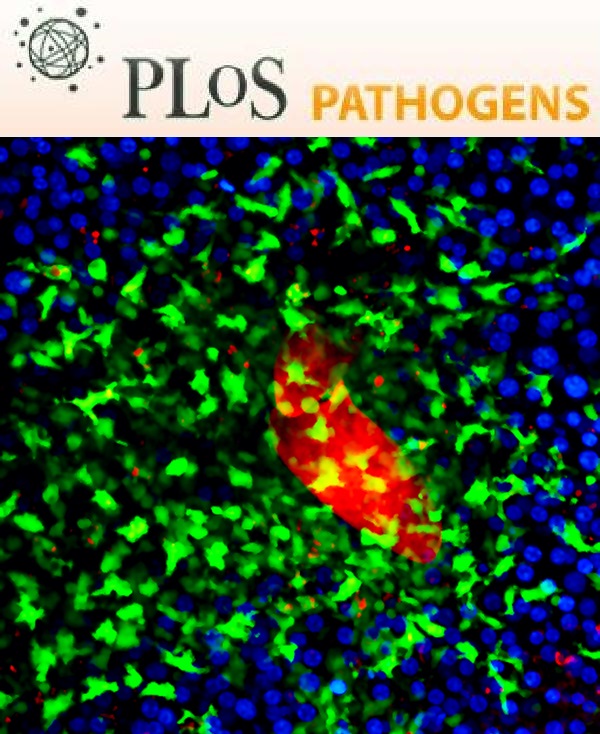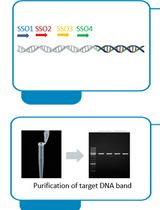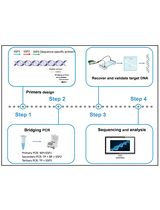- EN - English
- CN - 中文
Detection of piggyBac-mediated Transposition by Splinkerette PCR in Transgenic Lines of Strongyloides ratti
采用Splinkerette PCR检测类圆线虫转基因株系中的piggyBac介导转位
发布: 2014年01月05日第4卷第1期 DOI: 10.21769/BioProtoc.1015 浏览次数: 15134
评审: Fanglian He
Abstract
Splinkerette PCR (spPCR) is a newly developed and efficient method to ascertain and characterize genomic insertion sites of transgenes. The method described in this protocol was successfully applied to confirm piggyBac transposon-mediated integration of transgenes into chromosomes of the parasitic nematode Strongyloides ratti. This work is described in detail in Shao et al. (2012) and presented here in a simplified diagram (Figure 1). Using this method, chromosomal loci of integration were determined based on target site and 5’- and 3’ flanking sequences. Therefore, spPCR can be a useful method to confirm integrative transgenesis in functional genomic studies of parasitic nematodes. Potter and Luo (2010) contains a protocol for use of spPCR to detect and map piggyBac transposon-mediated chromosomal integrations in Drosophila, and was the source of our method for Strongyloides. The splinkerette- and piggyBac-specific oligos described in that reference could be used without modification in Strongyloides. For interested readers, a general review of the biology of parasitic nematodes in the genus Strongyloides may be found in Viney and Lok (2007), and a methods-based article on S. stercoralis as an experimental model, with information on transgenesis, may be found in Lok (2007).
Keywords: Strongyloides (粪)
Figure 1. Diagrammatic representation of protocol for mapping transgene integrations in Strongyloides by splinkerette PCR (adapted from Potter and Luo, 2010)
Materials and Reagents
- Free-living adult worms
- Genomic DNA extraction
Gentra Puregene Tissue Kit (QIAGEN), including - Enzymes for digestion and treatment
Restriction enzymes include BstY I, BamH I and Bgl II (New England Biolabs)
Others include Shrimp Alkaline Phosphatase (United State Biological, catalog number: P4071-05 ) and Exonuclease I (New England Biolabs, catalog number: M0293S ) - Ligation reagents
10x Ligase buffer and T4 Ligase (New England Biolabs, catalog number: M0202S ) - PCR reagents
5x Phusion High-Fidelity Buffer, Phusion HF DNA Polymerase (New England Biolabs, catalog number: M0530S ) - Oligonucleotides and primers
The oligonucleotides detailed in Table 1 must be synthesized
All sequences are from Potter and Luo (2010), Table S13 - TE buffer (New England Biolabs, catalog number: E6293 )
- 10x NEB Buffer 2
- 1% agarose gel
Table 1. Oligonucleotides and primers for splinkerette PCR mapping of piggyBac transposon-mediated transgene integrationsOligo or Primer Sequence SPLNK-BOT 5’-CGAAGAGTAACCGTTGCTAGGAGAGACCGTGGCTGAATGAGACTGGTGTCGACACTAGTGG-3’ SPLNK-GATC-TOP 5’-GATCCCACTAGTGTCGACACCAGTCTCTAATTTTTTTTTTCAAAAAAA-3’ SPLNK#1 5’-CGAAGAGTAACCGTTGCTAGGAGAGACC-3’ SPLNK#2 5’-GTGGCTGAATGAGACTGGTGTCGAC-3’ 3’SPLNK-PB#1 5’-GTTTGTTGAATTTATTATTAGTATGTAAG-3’ 5’SPLNK-PB#1 5’-ACCGCATTGACAAGCACG-3’ 3’SPLNK-PB#2 5’-CGATAAAACACATGCGTC-3’ 5’SPLNK-PB#2 5’-CTCCAAGCGGCGACTGAG-3’ 3’SPLNK-PB-SEQ 5’-ACGCATGATTATCTTTAAC-3’ 5’SPLNK-PB-SEQ 5’-CGACTGAGATGTCCTAAATGC-3’
Equipment
- PCR Thermal Cyclers (Mastercycler Personal, Eppendorf)
- Gel electrophoresis
- Gel documentation (FOTODYNE, model: FOTO/Analyst FX )
Procedure
文章信息
版权信息
© 2014 The Authors; exclusive licensee Bio-protocol LLC.
如何引用
Readers should cite both the Bio-protocol article and the original research article where this protocol was used:
- Shao, H. and Lok, J. B. (2014). Detection of piggyBac-mediated Transposition by Splinkerette PCR in Transgenic Lines of Strongyloides ratti. Bio-protocol 4(1): e1015. DOI: 10.21769/BioProtoc.1015.
- Shao, H., Li, X., Nolan, T. J., Massey, H. C., Jr., Pearce, E. J. and Lok, J. B. (2012). Transposon-mediated chromosomal integration of transgenes in the parasitic nematode Strongyloides ratti and establishment of stable transgenic lines. PLoS Pathog 8(8): e1002871.
分类
微生物学 > 微生物遗传学 > DNA > 转座子
分子生物学 > DNA > PCR
您对这篇实验方法有问题吗?
在此处发布您的问题,我们将邀请本文作者来回答。同时,我们会将您的问题发布到Bio-protocol Exchange,以便寻求社区成员的帮助。
Share
Bluesky
X
Copy link












